11. We have learned that before the Sun dominated the calendar
the midnight culminations of the stars seem to have determined
the positions in time-space, not only from Fomalhaut
culminating 4 days before the heliacal rising of Yang Mun
and Rijl al Awwa, but also from Sirius on one side
of the year and the pair Vega and Alphekka Meridiana
on the other:
 |
 |
 |
 |
 |
 |
 |
|
Bb1-15 |
Bb1-16 |
Bb1-17 |
→ 4
* 29½ |
Bb1-19 |
Bb1-20 |
Bb1-21 |
|
mai tae rere te manu ki te mea maa
i te rima |
kua rere ïa ki te veveke |
mai tae hokohuki - ia koia ra |
kua rerega a manu |
rere ki te hetu mai tae hua ia |
kua haga ia ki te mea o tona hare
pure |
|
Veve.
Pau.: miserable. Ta.: veve, poor,
needy, miserable. Churchill. Veveke, to hurry up,
hasten, quicken. Websters.
Pure.
Cowrie (Cypraea caput draconis);
pure vaka, another type of cowrie, which can float
on the sea like a diminutive boat (vaka). Vanaga.
1. To pray, to supplicate, invocation, prayer; hare
pure, church, chapel; tae pure, irreverence;
purega, prayer P Pau., Mgv., Mq., Ta.: pure,
to pray. In Samoa, Tonga, Niuē,
Futuna, Uvea, pule
means to command. 2. A shell T. P Pau.:
hakapurepure, to dye, to color. Mq.: pué, the
porcelain shell. Ta.: pure, a mark. Purepure,
spotted, dappled; ragi purepure, dappled sky.
Purepurea, spotted. P Pau.: hakapurepure, to
dye, to color. Mgv.: purepure, printed cloth;
akapurepure, to paint in different colors. Mq.:
puépué, covered with pale scars. Ta.: purepure,
spotted, dappled. Churchill.
Pureva, rock,
stone (small enough to be thrown by hand). Vanaga.
Pureva, to
throw a stone. Ta.:
Pureva, to be on the eve of going. Ha.:
puleva, to
float here and there. Churchill. Pau.: Pure-hiva,
a butterfly. Mgv.: pure-rehue, id. Ta.:
pure-hua, a moth. Mq.: pure-hua, id. Ma.:
pure-hua, id. Churchill.
Hare. House, family, home.
Vanaga. House, cabin, habitation, building, hut,
structure; hare iti, hut; hare itiiti
no, cabin; hare kahu, tent; hare
neinei, latrine; hare no iti, cell;
hare nunui, palace; hare pohurihuri,
prison; hare pure, chapel, church; ki te
hare, at home. Harepepe, kelp.
Harepiko, a. asylum, place of refuge; b. ambush,
snare. Harepopo, shed. Harepopokai,
storehouse. Churchill.
|
|
VISIBLE CLOSE TO THE
FULL MOON: |
|
CASTRA = ε
Capricorni
(327.2),
BUNDA = ξ Aquarii
(327.5)
SIRIUS (α Canis Majoris) |
Mahar sha hi-na Shahū-26 (Western
One in the Tail of the Goat)
NASHIRA (Fortunate
One) =
γ
Capricorni
(328.0),
ν
Oct. (328.3),
AZELFAFAGE (Tail of the Hen) =
π¹
Cygni,
κ
Capricorni (328.7) |
Arkat sha hi-na Shahū-27 (Eastern
One in the Tail of the Goat)
ENIF (The Nose) =
ε
Pegasi, ERAKIS =
μ
Cephei
(329.2),
46 CAPRICORNI, JIH (the Sun) =
κ
Pegasi
(329.3),
ι
Piscis Austrini (329.4),
λ
Capricorni (329.6),
ν
Cephei (329.7),
DENEB ALGIEDI =
δ
Capricorni
(329.8)
*288.0 = *329.4 - *41.4 |
θ
Piscis Austrini (330.1),
λ
Oct.
(330.7) |
KUH (Weeping) =
μ
Capricorni (331.4),
γ
Gruis (331.5)
*290.0 = *331.4 - *41.4 |
No star listed (300 + 32) |
η Piscis
Austrini (333.4)
*292.0 = *333.4 - *41.4 |

... The four bereaved
and searching divinities, the two mothers and their two
sons, were joined by a fifth, the moon-god Thoth (who
appears sometimes in the form of an ibis-headed scribe,
at other times in the form of a baboon), and together
they found all of Osiris save his genital member, which
had been swallowed by a fish ... |
|
Febr 11 |
12 (437 - 29) |
13 (*329) |
14 |
15 |
16 (412) |
17 (14 * 29½) |
|
9 (7 * 7 * 7) |
DEC 10 (344) |
11 |
12 |
13 (LUCIA) |
14 (348) |
15 |
|
INVISIBLY
CLOSE TO THE SUN: |
|
Star-25 (Horse) /
ANA-HEU-HEU-PO-5 (Pillar where
debates were held)
ALPHARD (The Horse) =
α
Hydrae
(142.3),
ω
Leonis (142.6),
τ¹
Hydrae (142.7)
|
Al Tarf-7 (The End)
ψ
Velorum (143.3),
ALTERF =
λ
Leonis,
τ²
Hydrae (143.4),
ξ
Leonis (143.5)
*102.0 = *143.4 - *41.4
|
A Hydrae
(144.1)
VEGA (α Lyrae)
|
Creation of our present world
UKDAH (Knot) =
ι
Hydrae (145.4),
κ
Hydrae (145.5),
SUBRA =
ο
Leonis
(145.8)
ALPHEKKA MERIDIANA
*104.0 = *145.4 - *41.4 |
5 Imix 9 Kumk'u
Rishu A.-13 (Head of the Lion)
ψ Leonis
(146.4),
RAS
ELASET AUSTRALIS = ε Leonis
(146.6)
*105.0 = *146.4 - *41.4 |
VATHORZ PRIOR = υ Carinae
(147.9) |
υ¹
Hydrae (148.4),
RAS ELASET BOREALIS (Northern Head of the Lion) =
μ
Leonis
(148.7)
*107.0 = *148.4 - *41.4 |
|
UKDAH (THE KNOT) |
|
Aug 10 |
11
(183 + 40) |
12 (224) |
13 (408 - 183) |
14 |
15 (227
→
π) |
16 |
|
JUNE 7 |
8 |
9 (224 - 64) |
10 (161) |
11 |
12 |
13 |
|
... Midsummer is the flowering season of the oak, which
is the tree of endurance and triumph, and like the ash
is said to 'court the lightning flash'. Its roots are
believed to extend as deep underground as its branches
rise in the air - Virgil mentions this - which makes it
emblematic of a god whose law runs both in Heaven and in
the Underworld ... The month, which takes its name from
Juppiter the oak-god, begins on June 10th and ends of
July 7th. Midway comes St. John's Day, June 24th, the
day on which the oak-king was sacrificially burned
alive. The Celtic year was divided into two halves with
the second half beginning in July, apparently after a
seven-day wake, or funeral feast, in the oak-king's
honour ... |
And from there we should remember that Yang Mun
culminated - at 21h like all the other prominent stars I have listed -
... Allen has documented all his star
culminations at 21h, which could be due to an effort of keeping
the culminations at their proper places according to the
ancients, 24h (spring equinox) - 21h = 3h = 24h / 8 = 45º. 3h
corresponds to 366 / 8 = 45.75 of my right ascension days and
*366 - *46 = *320 (Dramasa, σ
Octantis) ...
immediately after
the last star in the central triplet of Orion:

 |
 |
 |
 |
 |
|
Bb12-41 |
Bb12-42 |
Bb12-43 (504) |
Bb12-44 |
Bb12-45 (421 + 506) |
 |
|
Dec 13 (Lucia) |
14 (348) |
15 |
16 |
17 |
|
OCT 10 |
11
(284 → 2 * 84) |
12 |
13 |
14 |
|
λ
Arae (267.1),
GIRTAB
(Seizer) = κ Scorpii,
ο
Serpentis (267.6),
DSIBAN (Wolf Pair) =
ψ
Draconis
(267.9)
|
KELB ALRAI (Dog of the Shepherd) =
β
Ophiuchi,
μ Arae (268.1),
KEW HO (Nine Rivers) =
μ
Herculis
(268.6),
η
Pavonis (268.7),
APOLLYON
= ι Scorpii
(268.9) |
MULIPHEN (Oaths) =
γ
Ophiuchi
(269.0),
BASANISMUS = G Scorpii
(269.5),
PHERKARD (Dim One of the Two Calves) =
δ
Ursae Minoris
(269.9) |
PTOLEMY CLUSTER = M7 Scorpii
(270.5),
GRUMIUM (Lower Jaw) =
ξ
Draconis
(270.9) |
RUKBALGETHI GENUBI (Bending Claw) =
θ
Herculis
(271.1),
ξ
Herculis (271.5),
ETAMIN
(Head) = γ Draconis,
ν
Herculis (271.7),
ν
Ophiuchi (271.8) |
 |
|
June 13 (164 → 16 * 4) |
14 |
15 |
16 |
17 (168 → 2 * 84) |
|
MENKAURE
Three Stars-21 (Gibbon)
/
Shur-narkabti-sha-shūtū-6 (Star in
the Bull towards the south)
/
ANA-IVA-9 (Pillar of exit)
HEAVENLY
GATE = ζ Tauri,
ν
Columbae (84.0),
ω
Orionis (84.2),
ALNITAK (Girdle) =
ζ
Orionis,
PHAKT (Phaet) = α Columbae
(84.7) |
ο Aurigae (85.8), γ Leporis (85.9)
YANG MUN (α Lupi) |
μ Columbae (86.1),
SAIPH (Sword) = κ Orionis
(86.5), τ Aurigae, ζ Leporis (86.6) |
υ Aurigae (87.1), ν Aurigae (87.2),
WEZN
(Weight) = β Columbae,
δ Leporis (87.7),
TZE
(Son) = λ Columbae
(87.9) |
Ardra-6 (The Moist One)
/
ANA-VARU-8 (Pillar to sit by)
χ¹
Orionis,
ξ
Aurigae (88.1),
BETELGEUZE =
α
Orionis
(88.3),
ξ
Columbae (88.5),
σ
Columbae (88.7)
ZUBEN ELGENUBI (α Librae) |
|
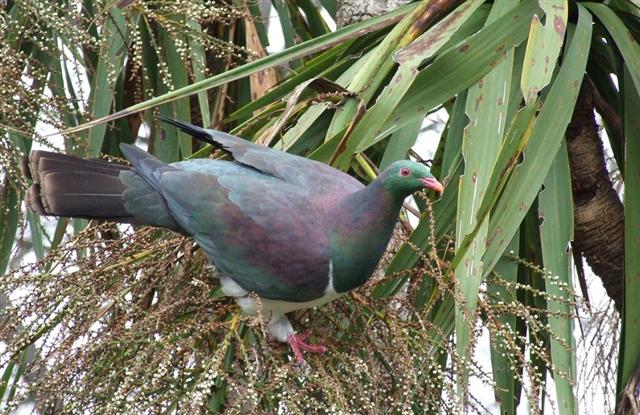
... An oracle reached him from the town of Buto,
which said 'six years only shalt thou live upon this
earth, and in the seventh thou shalt end thy days'.
Mycerinus, indignant, sent an angry message to
the oracle, reproaching the god with his injustice - 'My
father and uncle,' he said 'though they shut up the
temples, took no thought of the gods and destroyed
multitudes of men, nevertheless enjoyed a long life; I,
who am pious, am to die soon!' There came in reply a
second message from the oracle - 'for this very reason
is thy life brought so quickly to a close - thou hast
not done as it behoved thee ... |
|
'May 17 |
18 |
19 |
20 |
21 (141) |
|
"May 3 |
4 |
5 |
6 |
7 (127) |
|
APRIL 10 (100) |
11 |
12 |
13 |
14 (104) |
|
ki te mauga |
E ariki ra ku ria mauga |
kua rere ia |
ki te mauga |
ko te henua ia kua oti |
|
Riha.
Slow, tardy. Mgv.:
ria, id. Mq.:
iá, id. Ta.:
riha, id.
Rihariha: 1.
Feeble, cooked too much. 2. Greedy. Mq.:
ihaiha,
gorged, stomach filled to repletion. Churchill.
Oti.
To come to an end; to suffice, to be enough:
ku-oti-á, it is finished; ina kai oti mo kai,
there is not enough to eat; he-oti á, there isn't
anymore left, it's the last one; it's enough with that.
Vanaga. Ta.: 1. Oti, presage of death. Sa.:
oti, to die. 2. To cut. Mq.: koti, oti,
id. Sa.: 'oti, id. Ma.: koti, id.
Churchill.
According to Metoro this was 3 days
before te henua
ia kua oti, which I guess meant a piece of Land 'cut
off' from the mainland (cfr
Moku-ola).
|
BETELGEUZE |
177 (→ 6
* 29½) |
265 (→
365 - 100) |
|
88.3 |
2 * 88.3 |
3 * 88.3 |
|
88 |
176 |
264 |
|
176 *
3 = 528 |
This idea could have been
illustrated in how there was a little
henua
piece of land (an islet, motu) separated from
the left main part (air-land-water) of the great
glyph illustrating ending with a 'flipper' (for moving
down in the water) in
Gb7-30
- where the Full Moon was at the right ascension
line of Arcturus.

... The 'classic'
version, however, was much more detailed: the rope
would seem to rise high into the skies, disappearing
from view. The boy would climb the rope and be lost
to view. The magician would call back his boy
assistant, and, on getting no response, become
furious. The magician then armed himself with a
knife or sword and climbed the rope, vanishing too.
An argument would be heard, and then limbs would
start falling, presumably cut from the assistant by
the magician. When all the parts of the body,
including the torso,
landed on the ground, the magician would climb down
the rope. He would collect the limbs and put them in
a basket, or collect the limbs in one place and
cover them with a cape or blanket. Soon the boy
would appear, restored ...
|
On Easter Island they had a Rigel year
... In view of the almost universal prevalence of the
Pleiades year throughout the Polynesian area it is
surprising to find that in the South Island and certain
parts of the North Island of New Zealand and in the
neighboring Chatham Islands, the year began with the new
Moon after the yearly morning rising, not of the
Pleiades, but of the star Rigel [*78] in Orion ...
and therefore it is
reasonable to assume the exit endings at glyph lines
Bb3 and Ea3 might be due to some connection with Orion.
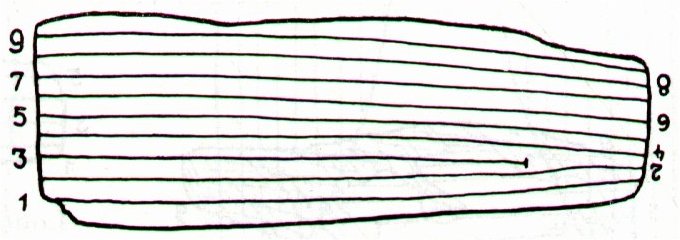
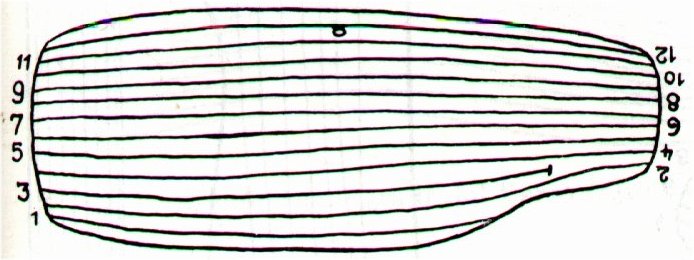
 |
 |
 |
|
Bb3-41 (540 = 3 * 180) |
Bb3-42 (541 -
421 = 120) |
Bb3-43 (542 =
177 + 365) |
|
Itzam-Yeh
defeated |
28 May (148 = 225 -
77), 3149 BC |
|
1st 3-stone place |
21 May (141 = 225 -
84), 3114 BC |
|
Creation of our
present world |
13 August (225), 3114
BC |
|
Och ta chan
(Hun-Nal-Ye 'entered or became the
sky') |
5 February (36 = 141
- 105), 3112 BC |
|
21 May, 3114 BC - 5 February, 3112
BC = 224 + 282 + 36 =
506 + 36 = 542
542 'happens to be'
the sum of 365 days and 6 * 29½
nights. |
|
|
mai tae vere
hia - ki te pito o
te henua |
e nuku hoi |
kua here te toa - i ruga o to
maro |
|
Vere. 1. Beard, moustache (vede
G); vere gutu, moustache; verevere,
shaggy, hairy, tow, oakum. Mgv.: veri,
bristly, shaggy, chafed (of a cord long in use).
Mq.: veevee, tentacles. Ta.: verevere,
eyelash. 2. To weed (ka-veri-mai, pick,
cut-grass T); verevere, to weed. P Mgv.:
vere, to weed. Mq.: veéveé,
vavee, id. 3. Verega, fruitful,
valuable; verega kore, unfruitful,
valueless, contemptible, vain, futile,
frivolous; tae verega, insignificant,
valueless; mataku verega kore, scruple.
Mgv.: verega, a design put into
execution; one who is apte, useful, having a
knowledge how to do things. 4. Ta.: verevere,
pudenda muliebria. Ma.: werewere, id.
(labia minora). Churchill. Sa.:
apungaleveleve, apongaleveleve, a
spider, a web. To.: kaleveleve, a large
spider. Fu.: kaleveleve, a spider, a web.
Niuē:
kaleveleve, a
cobweb. Nukuoro: halaneveneve,
a spider. Uvea: kaleveleve,
a spider. Mgv.: pungaverevere,
a spider. Pau.: pungaverevere,
cloth. Mg.: pungaverevere,
a cobweb. Ta.: puaverevere,
id. Mao.: pungawerewere,
puawerewere,
puwerewere,
a spider. Ha.: punawelewele,
a spider, a web. Mq.: pukaveevee,
punaveevee,
id. Vi.: lawa,
a fishing net; viritālawalawa,
a cobweb; butalawalawa,
a spider. Churchill 2.

Pito. 1. Umbilical cord; navel;
centre of something: te pito o te henua,
centre of the world. Ana poreko te poki, ina
ekó rivariva mo uru ki roto ki te hare o here'u
i te poki; e-nanagi te pito o te poki, ai
ka-rivariva mo uru ki roto ki te hare, when
a child is born one must not enter the house
immediately, for fear of injuring the child
(that is, by breaking the taboo on a house where
birth takes place); only after the umbilical
cord has been severed can one enter the house.
2. Also something used for doing one's buttons
up (buttonhole?). Vanaga. Navel. Churchill. H
Piko 1. Navel, navel string, umbilical cord.
Fig. blood relative, genitals. Cfr piko pau
'iole, wai'olu. Mō ka piko, moku
ka piko, wehe i ka piko, the navel cord is
cut [friendship between related persons is
broken; a relative is cast out of a family].
Pehea kō piko? How is your navel [a
facetious greeting avoided by some because of
the double meaning]? 2. Summit or top of a hill
or mountain; crest; crown of the head; crown of
the hat made on a frame (pāpale pahu);
tip of the ear; end of a rope; border of a land;
center, as of a fishpond wall or kōnane
board; place where a stem is attached to the
leaf, as of taro. 3. Short for alopiko.
I ka piko nō 'oe, lihaliha (song), at the
belly portion itself, so very choice and fat. 4.
A common taro with many varieties, all with the
leaf blade indented at the base up to the
piko, junction of blade and stem. 5. Design
in plaiting the hat called pāpale 'ie. 6.
Bottom round of a carrying net, kōkō. 7.
Small wauke rootlets from an old plant.
8. Thatch above a door. 'Oki i ka piko,
to cut this thatch; fig. to dedicate a house.
Wehewehe. Hoki. To
return, to go back, to come back;
ka hoki ki rá, go back there! ana oho
koe ki Hiva, e hoki mai ki nei, if you go to
the mainland, do come back here again. Vanaga.
1. Also, what; ki ra hoki, precisely
there; pei ra hoki, similitude, likeness;
pei ra hoki ta matou, usage. P Pau.:
hokihoki, often. Mgv.: hoki, also,
and, likewise. Mq.: hoi, surely. Ta.:
hoi, also, likewise. 2. To return, to turn
back, to draw back, to give back, to tack;
mau e hoki mai, to lend; hoki hakahou,
to carry back; hoki amuri, to retrograde;
hakahoki, to bring back, to send back, to
carry back, to restore, to renew, to revoke, to
remove, to dismiss, to pay, to pardon, to
compress; hakahokia, given up;
hakahokihaga, obligation. P Pau.:
hokihoki, to persist, to insist; fakahoki,
to give back. Mgv.: hoki, to return, to
retrace one's steps; oki, to return, to
come back. Ta.: hoi, to return, to come
back. Ta.: mahoi, the essence or soul of
a god. Churchill. |
|
Nov 25 → 9 * 25 = 225 |
26 (330) |
27 |
|
Al Kalb-16 (The Heart)
/
Jyeshtha-18 (Eldest)
/
ANA-MUA-1 (Entrance
pillar)
ANTARES = α Scorpii
(249.1),
MARFIK (Elbow) = λ Ophiuchi,
φ Ophiuchi (249.5), ω Ophiuchi (249.8) |
γ Apodis (250.1), σ Herculis (250.3), θ Tr.
Austr. (250.6),
τ Scorpii
(250.7) |
HAN = ζ Ophiuchi
(251.0) |
|
... In China, with
Capricornus, Pisces, and a part of Sagittarius,
it [Aquarius] constituted the early Serpent, or
Turtle, Tien Yuen; and later was known as
Hiuen Ying, the Dark Warrior and Hero, or
Darkly Flourishing One, the Hiuen Wu, or
Hiuen Heaou, of the
Han dynasty, which Dupuis gave as
Hiven Mao. It was a symbol of the emperor
Tchoun Hin, in whose reign was a great
deluge; but after the Jesuits came in it became
Paou Ping, the Precious Vase. It
contained three of the sieu, and headed the list
of zodiac signs as the Rat, which in the
far East was the ideograph for 'water', and
still so remains in the almanacs of Central
Asia, Cochin China, and Japan ...

|
|
RIGHT
ASCENSION DAYS AT THE FULL MOON: |
|
No star listed (66) |
No star listed (67) |
Rohini-4 (The Red One)
/
Pidnu-sha-Shame-4 (Furrow
of Heaven)
/
ANA-MURI-2 (Rear pillar - at the foot of which
was the place for tattooing)
ALDEBARAN = α Tauri
(68.2),
THEEMIN = υ² Eridani
(68.5) |
|
May 26 |
27 (80 + 67 =
147) |
28 (148 = 225
- 77) |
|
'April 29 |
30 (120 = 147
- 27 |
'May 1 (121) |
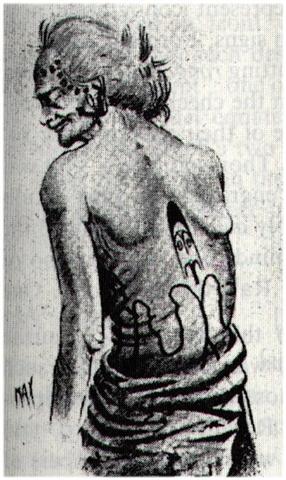 |
The number of glyphs on side b of the B tablet had been
determined to be 506 (= 542 - 36 = 927 - 421, cfr Bb12-45
above), and presumably this number was referring to December 31 (=
36 days before February 5 - which according to the Mayas
was the place of Och ta chan when Hun-Nal-Ye 'entered or became the
sky', see above). Probably this was intended as a Sign in order to measure
out the distance from May 21 (141, the first 3-stone place) to
the end of the year.
Furthermore, the
Opener of the Way was the Wolf-god (Upwaut).
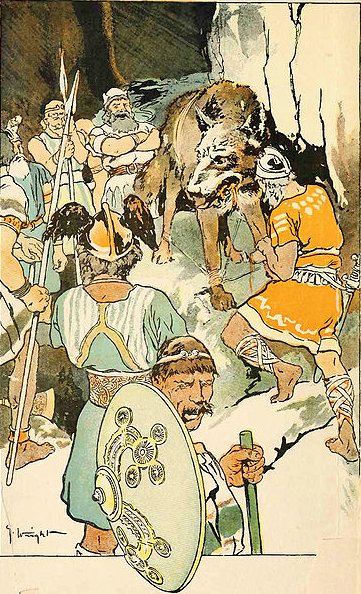
... At the beginning of 44 B.C. - when Ceasar
was still alive - the Senate decided to raise statues of him in
all the temples and to sacrifice to him on his birthday in the
month Quintilis, which in honour of him was renamed July.
He was raised to the status of a god
(among the other gods of the state) under the name Jupiter
Julius. Marcus Antonius, who this year was consul together with
Caesar, became high priest and responsible for the ceremonies.
In the middle of February, at the time of the old feast of
Lupercalia [Lupus = Wolf], he ran around naked and
whipped the Roman ladies with thongs made from goat-skin [februa],
in order to promote their fertility ...
.jpg)
... The king,
wearing now a short, stiff archaic mantle, walks in a grave and
stately manner to the sanctuary of the wolf-god Upwaut,
the 'Opener of the Way', where he anoints the sacred standard
and, preceded by this, marches to the palace chapel, into which
he disappears. A period of time elapses during which the pharaoh
is no longer manifest.
When he reappears
he is clothed as in the Narmer palette, wearing the kilt with
Hathor belt and bull's tail attatched. In his right hand he
holds the flail scepter and in his left, instead of the usual
crook of the Good Shepherd, an object resembling a small scroll,
called the Will, the House Document, or Secret of the Two
Partners, which he exhibits in triumph, proclaiming to all in
attendance that it was given him by his dead father Osiris,
in the presence of the earth-god Geb. 'I have run', he
cries, 'holding the Secret of the Two Partners, the Will that my
father has given me before Geb. I have passed through the
land and touched the four sides of it. I traverse it as I
desire.' ...
Which presumably was alluded
to by
Toliman (α Centauri at the
right front hoof of the Horse Man and the star closest to
our Sun) → TERMINALIA,
cfr the illustration of Hevelius further down below. And notice the half Man at the line separating the 3rd from the 4th
quarter with the Sign of Saturn:

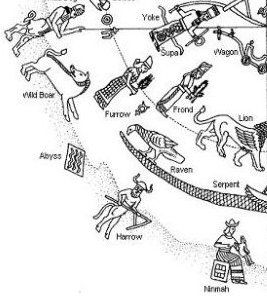
|
NAMES
OF SATURN |
|
Hawaiian Islands |
Society Islands |
New Zealand |
Pukapuka |
|
Naholoholo,
'Swift-running'
Makulu, 'Dripping-water' |
Fetu-tea, 'Pale-star' |
Parearau, 'Circlet'
Kopu-nui, 'Great-paunch' |
Mata-tea, 'Pale-star' |
Saturn was moving slowly as if old and therefore the curious name 'Swift-running'
could have
referred to his position at autumn equinox (away from the pair
of solstice places where the Sun moved extremely slow).

 |
 |
 |
 |
 |
|
Bb3-9
(421 + 87 = 508) |
Bb3-10 (88) |
Bb3-11 (145 + 365) |
Bb3-12 ↔
Aa1-41 |
Bb3-13 (87 + 4 = 91) |
|
haati kava |
mai tae tuki to
tauuru |
nuku |
te uru papageti |
tagata oho |
|
RIGHT
ASCENSION DAYS AT THE FULL MOON: |
|
April
24 (50 + 64) |
25 (115
→
460 / 4) |
26 (→
177 - 61) |
27 |
28
(118 = 4 * 29½) |
|
"March 14 (→ π) |
15
(74 = 115 - 41) |
16 |
17 |
18 (77) |
|
FEBR 19 (50
= 34 + 16) |
20
(115 - 64) |
21
(52) |
22 |
TERMINALIA |
|
...
When it was evident that the years lay
ready to burst into life, everyone took
hold of them, so that once more would
start forth - once again - another
(period of) fifty-two years. Then (the
two cycles) might proceed to reach one
hundred and four years. It was called
One Age when twice they had made the
round, when twice the times of binding
the years had come together. Behold what
was done when the years were bound -
when was reached the time when they were
to draw the new fire, when now its count
was accomplished. First they put out
fires everywhere in the country round.
And the statues, hewn in either wood or
stone, kept in each man's home and
regarded as gods, were all cast into the
water. Also (were) these (cast away) -
the pestles and the (three) hearth
stones (upon which the cooking pots
rested); and everywhere there was much
sweeping - there was sweeping very
clear. Rubbish was thrown out; none lay
in any of the houses ...
Nuku.
1. Pau.: nuka, crowd,
throng. Ta.: nuú, army, fleet.
Mg.: nuku, a host, army. 2. Mgv.:
nuku, land, country, place. Sa.:
nu'u, district, territory,
island. Churchill.
... 1. Hanga Te
Pau, the landing site of Ira
and his band of explorers, is the
natural anchorage for those approaching
Vinapu by sea. The remarkable
stone fronts of the ahu of
Vinapu are all facing the sea. The
explorers landed at Hanga Te Pau
during the month 'Maro', that is,
June ... 2. The cult place of Vinapu
is located between the fifth and sixth
segment of the dream voyage of Hau
Maka. These segments, named 'Te
Kioe Uri' (inland from Vinapu)
and 'Te Piringa Aniva' (near
Hanga Pau Kura) flank Vinapu
from both the west and the east. The
decoded meaning of the names 'the dark
rat' (i.e., the island king as the
recipient of gifts) and 'the gathering
place of the island population' (for the
purpose of presenting the island king
with gifts) links them with the month 'Maro',
which is June. Thus the last month of
the Easter Island year is twice
connected with Vinapu. Also, June
is the month of summer solstice, which
again points to the possibility that the
Vinapu complex was used for
astronomical purposes. 3. On the 'second
list of place names', Hanga Te Pau
is called 'the middle (zenith) of the
land' (he tini o te kainga). This
may refer to a line bisecting the
island, but it can just as easily mean
the gathering of a great number (of
islanders) [→
nuku].
The plaza (130 x 130 meters) would have
been very well suited for this purpose
...
 |
|
No star listed (34) |
ξ Arietis (35.0),
ρ Ceti (35.4),
12 Trianguli
(35.8), ξ² Ceti (35.9)
*360.0 = *35.4 - *41.4 |
σ Ceti (36.9) |
ν Ceti (37.9) |
ν Arietis (38.5), δ, ε Ceti (38.8) |
|
Sumerian SAG |
 |
Phoenician resh |
 |
Greek rho |
Ρ (ρ) |
|
... Resh
(Arabic: rāۥ)
is the twentieth letter of many
Semitic alphabets, including
Phoenician, Aramaic, Hebrew ...
The word resh is usually
assumed to have come from a
pictogram of a head, ultimately
reflecting Proto-Semitic *raۥ(i)š-.
The word's East Semitic cognate,
rēš-, was one possible
phonetic reading of the Sumerian
cuneiform sign for 'head' (SAG).

.jpg)
... Then I
become aware of ... a presence -
a faint, ghostly glimmering,
like moonglow, that has appeared
on the solstice stone. I don't
know how long it lasts, a second
or two only I would guess, but
while it is there it seems less
like a projection - which I know
it to be - than something
immanent within the stone
itself. And it seems to function
as a herald for it fades almost
as soon as it has appeared and
in its place the full effect
snaps on - instantaneously. It
wasn't there, and then it's
there. As Chris had described,
the effect does curiously
resemble a poleaxe, or a flag on
a pole, and consists of a
'shaft', narrow at the base but
widening a little towards the
top, running up the left hand
side of the solstice stone,
surmounted by a right-facing
'head' or 'flag'. An instant
later an almond-shaped spot of
light, like an eye, appears a
few centimeters to the right of
the 'flag' and the effect is
complete. Weirdly - I do not
claim it has any significance -
this flag-on-a-pole symbol is
the ancient Egyptian hieroglyph
neter, meaning 'god', or
'a god' - and not to be
understood at all in the
Judaeo-Christian usage of that
word but rather as a reference
to one of the supernatural
powers or principles that guide
and balance the universe.
Manifested here, in this strange
Stone Age temple, it glows, as
though lit by inner fire
...

Marija Gimbutas: 'To sleep
within the Goddess's womb was to
die and to come to life anew'.
In a system of reincarnation the
old one must die in order to be
reborn, of course. At midsummer
Sun comes to a standstill, and
this must therefore be an
occasion when the 'flame of
life' had to be transported into
a new body. |
|
|
RIGHT
ASCENSION DAYS AT THE SUN: |
|
Oct
24 |
25 (115 + 183) |
26
(360 - 61) |
27
(300) |
28 |
|
"Sept
13 |
14 |
15 |
16
(300 - 41) |
17
(260) |
|
AUG
21 |
22 |
23 |
24
(300 - 64) |
25 (237) |
|
ASELLUS PRIMUS (1st Ass Colt) =
θ
Bootis
(217.8) |
τ
Lupi,
δ
Oct. (218.1),
φ
Virginis (218.7)
FOMALHAUT (α Piscis Austrini) |
σ
Lupi (219.1),
ρ
Bootis (219.5),
HARIS (Keeper) =
γ
Bootis
(219.7)
FUM AL SAMAKAH (β
Piscium) |
σ Bootis (220.2),
η Centauri (220.4)
*179.0 = *220.4 - *41.4 |
ρ Lupi (221.0),
TOLIMAN = α
Centauri
(221.2), π Bootis (221.8), ζ Bootis
(221.9) |
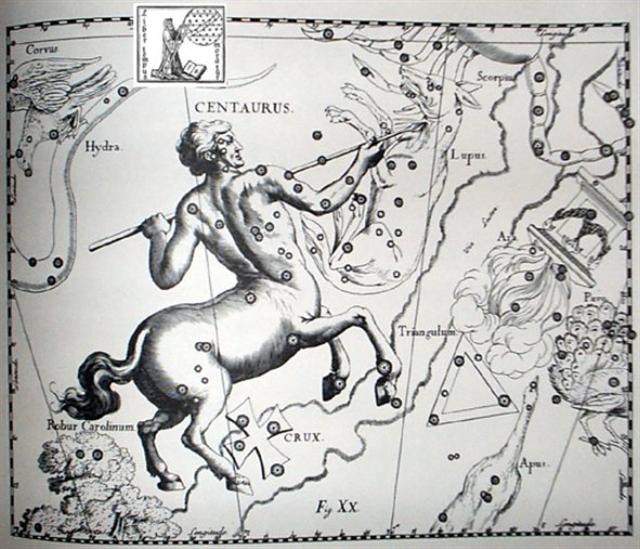 |

|





















.jpg)




.jpg)


